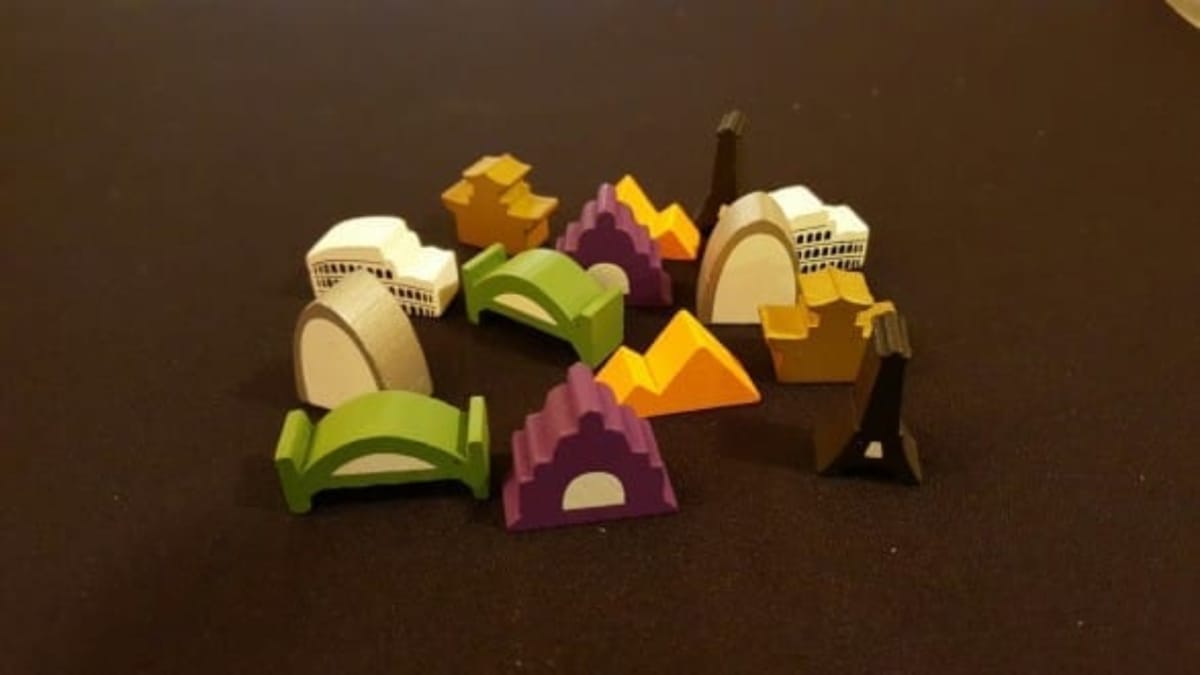Check out our Between Two Cities review to get our opinion on the latest modern classic from Stonemaier Games.
Between Two Cities Review - City Builder
Between Two Cities, designed by Ben Rosset and Matthew O'Malley and published by Stonemaier Games, isn't the most immediately exciting game on the market. The core concept of the game's city building is easy enough for players to wrap their heads around, but the fact that each player shares the construction of two cities with the players to their left and right takes a bit of adjustment. The fact that players count the lower score of the two cities that they helped construct takes even more adjustment. Fortunately, once players hit their "ah ha!" moment, which usually happens in the first few minutes of gameplay, Between Two Cities really shines.

The gameplay in Between Two Cities is fairly simple. Each round, each player drafts two tiles and places one in the city to their left and one in the city to their right. Players have to work with their immediate neighbors to place tiles in the most efficient way possible in order to score the most points. Players choose which tiles they are going to place without any input from their neighbors, but must directly work together with those same neighbors when deciding where the chosen tiles will be placed.

While it may seem strange to have players count the lower score of the two cities that they helped construct, it is an ingenious solution to prevent players from teaming up to create one super-city while putting little effort into the other city. If players put all of their eggs in one basket, they may end up with the highest scoring city overall, but that city will effectively be removed from end game scoring, leaving the negligent player with a much lower score.

Drafting tiles is elegant and fun, but the real beauty of Between Two Cities resides in the construction of the cities themselves. The game absolutely encourages coordination, communication, and positive interaction between players as they work together to build the best city they possibly can. That positive interaction takes place between each player and both of their neighbors, which means that the game actually gets better as the overall player count increases.

Given the choice, I'd play Between Two Cities with the maximum 7 players every time, which is an incredible feat on its own. Add in the fact that playtime doesn't noticeably increase as player count climbs and you have something special. The higher player count actually increases the motivation to work more closely with each neighbor. With three players, you have to work together while competing directly against each other. With 7, the game feels like you are working with your team of neighbors to prove that, as a team, you can be better than the other teams around the table.

Between Two Cities doesn't quite have the depth to form the core of a game night, the symbolism is tricky for players to wrap their heads around, and final scoring can be a bit confusing, especially trying to figure out who won in a 7 player game. Despite these few minor flaws, it is the perfect type of game to bring to the table on a whim during a family gathering or when the number of people available to play is a bit too high for most other games to accommodate. Gameplay is easy to teach and the coordination aspect is enough that even non-gamers will not only have fun, but can be competitive from their very first game.

A note on solo play
Between Two Cities has rules for solo play although, playing solo, you really miss out on the best aspects of the game. Play Between Two Cities with as many people as you can for the best experience.
A note on “chrome”
Stonemaier Games are known for excellent component quality, and Between Two Cities is no exception. The components are excellent, the cardstock is thick, and the cards are nice and easy to shuffle. One really nice touch is the scoreboard, which has a snaking score track on one side and a static, left to right track on the other. Small touches like this are always greatly appreciated. While the symbolism on the tiles themselves isn't immediately clear, the rulebook is easy to read and the gameplay can be taught to new players in a few short minutes.
The Bottom Line
Between Two Cities is a great game that is best with a full complement of 7 players. Coordinating with your two neighbors to build the best possible city is fun, and the game actively encourages positive interactions throughout. Played in about 30 minutes, Between Two Cities is the perfect game to break out when extra people show up to game night or at family gatherings when you want to play a game that encourages interaction.
Get this game if:
You enjoy games that encourage socialization.
You like the city building theme.
You like quick games that play in 30 minutes or less.
You want a game that plays 7 people that remains a game and doesn't devolve into simply an activity.
Avoid this game if:
You are looking for a game to play primarily solo.
You prefer directly competitive games.
The copy of Between Two Cities used for this review was provided by Stonemaier Games.
Review Summary
Have a tip, or want to point out something we missed? Leave a Comment or e-mail us at tips@techraptor.net












